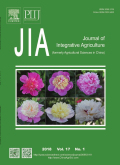- 钛学术文献服务平台 \
- 学术期刊 \
- 农业科学期刊 \
- 农业科学总论期刊 \
- 农业科学学报(英文)期刊 \
Improving winter wheat grain yield and water-/nitrogen-use efficiency by optimizing the micro-sprinkling irrigation amount and nitrogen application rate
Improving winter wheat grain yield and water-/nitrogen-use efficiency by optimizing the micro-sprinkling irrigation amount and nitrogen application rate
基本信息来源于合作网站,原文需代理用户跳转至来源网站获取
摘要:
Available irrigation resources are becoming increasingly scarce in the North China Plain (NCP), and nitrogen-use efficiency of crop production is also relatively low. Thus, it is imperative to improve the water-use efficiency (WUE) and nitrogen fertilizer productivity on the NCP. Here, we conducted a two-year field experiment to explore the effects of different irrigation amounts (S60, 60 mm; S90, 90 mm; S120, 120 mm; S150, 150 mm) and nitrogen application rates (150, 195 and 240 kg ha–1; denoted as N1, N2 and N3, respectively) under micro-sprinkling with water and nitrogen combined on the grain yield (GY), yield components, leaf area index (LAI), flag leaf chlorophyll content, dry matter accumulation (DM), WUE, and nitrogen partial factor productivity (NPFP). The results indicated that the GY and NPFP increased significantly with increasing irrigation amount, but there was no significant difference between S120 and S150; WUE significantly increased first but then decreased with increasing irrigation and S120 achieved the highest WUE. The increase in nitrogen was beneficial to improving the GY and WUE in S60 and S90, while the excessive nitrogen application (N3) significantly reduced the GY and WUE in S120 and S150 compared with those in the N2 treatment. The NPFP significantly decreased with increasing nitrogen rate under the same irrigation treatments. The synchronous increase in spike number (SN) and 1000-grain weight (TWG) was the main reason for the large increase in GY by micro-sprinkling with increasing irrigation, and the differences in SN and TGW between S120 and S150 were small. Under S60 and S90, the TGW increased with increasing nitrogen application, which enhanced the GY, while N2 achieved the highest TWG in S120 and S150. At the filling stage, the LAI increased with increasing irrigation, and greater amounts of irrigation significantly increased the chlorophyll content in the flag leaf, which was instrumental in increasing DM after anthesis and increasing the TGW. Micro-sprinkling with increased amounts of irrigation or excessive nitrogen application decreased the WUE mainly due to the increase in total water consumption (ET) and the small increase or decrease in GY. Moreover, the increase in irrigation increased the total nitrogen accumulation or contents (TNC) of plants at maturity and reduced the residual nitrate-nitrogen in the soil (SNC), which was conducive to the increase in NPFP, but there was no significant difference in TNC between S120 and S150. Under the same irrigation treatments, an increase in nitrogen application significantly increased the residual SNC and decreased the NPFP. Overall, micro-sprinkling with 120 mm of irrigation and a total nitrogen application of 195 kg ha–1 can lead to increases in GY, WUE and NPFP on the NCP.

推荐文章
Effects and underlying mechanisms of damming on carbon and nitrogen cycles and transport in rivers o
Damming
Carbon and nitrogen cycles
Southwest Chinese rivers
Ecological stoichiometry of nitrogen, phosphorous, and sulfur in China's forests
Forest
Stoichiometry
Nitrogen
Phosphorous
Sulfur
China
A study of groundwater irrigation water quality in south-central Bangladesh: a geo-statistical model
Semivariogram
Ordinary kriging model
Salinity
Irrigation water quality index
GIS
Hydrochemistry
In-situ nitrogen fate in the vadose zone of different soil types and its implications for groundwate
Vadose zone
Silty-loam
Silty-clay-loam
Nitrogen transformation
Groundwater vulnerability
Stable isotopes
内容分析
关键词云
关键词热度
相关文献总数
(/次)
(/年)
文献信息
| 篇名 | Improving winter wheat grain yield and water-/nitrogen-use efficiency by optimizing the micro-sprinkling irrigation amount and nitrogen application rate | ||
| 来源期刊 | 农业科学学报(英文) | 学科 | |
| 关键词 | |||
| 年,卷(期) | 2021,(2) | 所属期刊栏目 | Section 4: Effective management strategies for closing yield and efficiency gaps |
| 研究方向 | 页码范围 | 606-621 | |
| 页数 | 16页 | 分类号 | |
| 字数 | 语种 | 英文 | |
| DOI | 10.1016/S2095-3119(20)63407-4 | ||
五维指标
引文网络
引文网络
二级参考文献 (154)
共引文献 (60)
参考文献 (33)
节点文献
引证文献 (0)
同被引文献 (0)
二级引证文献 (0)
1980(1)
- 参考文献(0)
- 二级参考文献(1)
1985(1)
- 参考文献(0)
- 二级参考文献(1)
1990(1)
- 参考文献(0)
- 二级参考文献(1)
1995(2)
- 参考文献(0)
- 二级参考文献(2)
1996(2)
- 参考文献(0)
- 二级参考文献(2)
1997(2)
- 参考文献(0)
- 二级参考文献(2)
1998(2)
- 参考文献(1)
- 二级参考文献(1)
1999(2)
- 参考文献(0)
- 二级参考文献(2)
2000(4)
- 参考文献(0)
- 二级参考文献(4)
2001(2)
- 参考文献(0)
- 二级参考文献(2)
2002(6)
- 参考文献(0)
- 二级参考文献(6)
2003(9)
- 参考文献(0)
- 二级参考文献(9)
2004(5)
- 参考文献(0)
- 二级参考文献(5)
2005(7)
- 参考文献(0)
- 二级参考文献(7)
2006(14)
- 参考文献(1)
- 二级参考文献(13)
2007(15)
- 参考文献(0)
- 二级参考文献(15)
2008(12)
- 参考文献(0)
- 二级参考文献(12)
2009(13)
- 参考文献(3)
- 二级参考文献(10)
2010(8)
- 参考文献(0)
- 二级参考文献(8)
2011(13)
- 参考文献(1)
- 二级参考文献(12)
2012(10)
- 参考文献(1)
- 二级参考文献(9)
2013(10)
- 参考文献(3)
- 二级参考文献(7)
2014(13)
- 参考文献(1)
- 二级参考文献(12)
2015(7)
- 参考文献(4)
- 二级参考文献(3)
2016(8)
- 参考文献(3)
- 二级参考文献(5)
2017(7)
- 参考文献(4)
- 二级参考文献(3)
2018(7)
- 参考文献(7)
- 二级参考文献(0)
2019(4)
- 参考文献(4)
- 二级参考文献(0)
2021(0)
- 参考文献(0)
- 二级参考文献(0)
- 引证文献(0)
- 二级引证文献(0)
引文网络交叉学科
相关学者/机构
期刊影响力
农业科学学报(英文)
主办单位:
中国农业科学院农业信息研究所
出版周期:
月刊
ISSN:
2095-3119
CN:
10-1039/S
开本:
出版地:
北京中关村南大街12号
邮发代号:
创刊时间:
语种:
eng
出版文献量(篇)
4703
总下载数(次)
0
期刊文献
相关文献
推荐文献
- 期刊分类
- 期刊(年)
- 期刊(期)
- 期刊推荐
农业科学学报(英文)2022
农业科学学报(英文)2021
农业科学学报(英文)2020
农业科学学报(英文)2019
农业科学学报(英文)2018
农业科学学报(英文)2017
农业科学学报(英文)2016
农业科学学报(英文)2015
农业科学学报(英文)2014
农业科学学报(英文)2013
农业科学学报(英文)2012
农业科学学报(英文)2011
农业科学学报(英文)2010
农业科学学报(英文)2009
农业科学学报(英文)2008
农业科学学报(英文)2007
农业科学学报(英文)2006
农业科学学报(英文)2005
农业科学学报(英文)2004
农业科学学报(英文)2003
农业科学学报(英文)2002
农业科学学报(英文)2001
农业科学学报(英文)2000
农业科学学报(英文)2021年第9期
农业科学学报(英文)2021年第8期
农业科学学报(英文)2021年第7期
农业科学学报(英文)2021年第6期
农业科学学报(英文)2021年第5期
农业科学学报(英文)2021年第4期
农业科学学报(英文)2021年第3期
农业科学学报(英文)2021年第2期
农业科学学报(英文)2021年第12期
农业科学学报(英文)2021年第11期
农业科学学报(英文)2021年第10期
农业科学学报(英文)2021年第1期

 免费查重
免费查重










